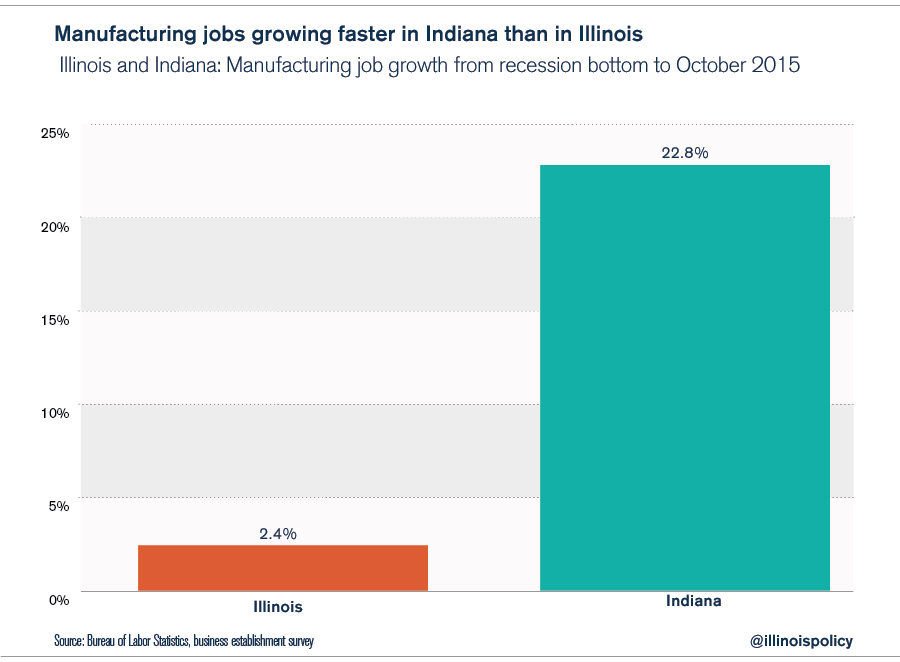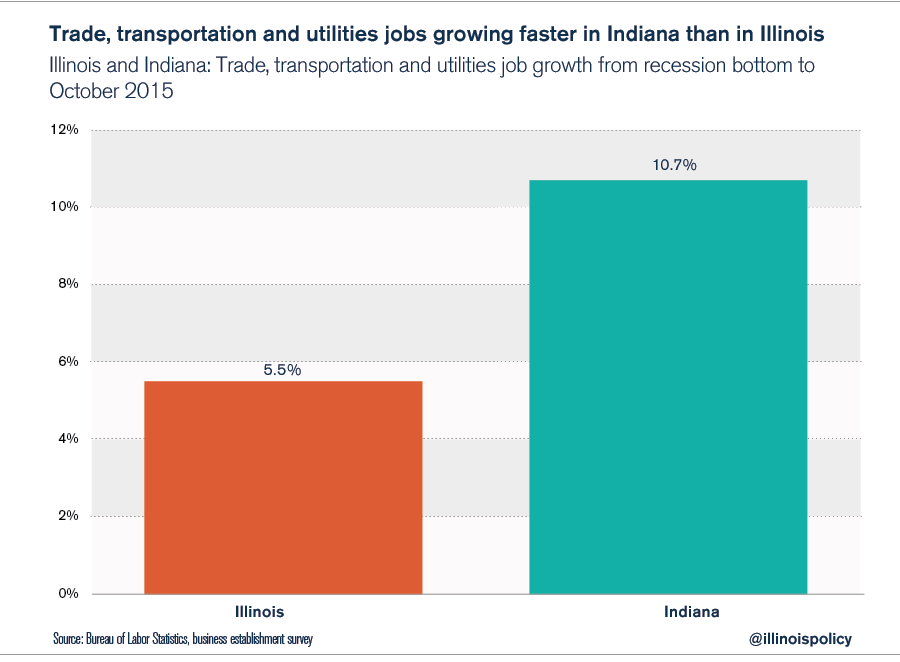Illinois’ anti-growth policies depress middle-class wages and job opportunities.
Blue-collar workers earn more in Indiana than they do in Illinois, according to the most recentoccupational wage data from the Bureau of Labor Statistics, or BLS. And blue-collar job creation is much stronger in Indiana, too.
Yet Illinois House Speaker Mike Madigan has consistently claimed that he opposes Gov. Bruce Rauner’s entire reform agenda because it would reduce the wages and standard of living for middle-class families in Illinois. A true defender of the middle class would notice that while these people in Illinois are suffering, their counterparts in Indiana, Wisconsin, Iowa and Missouri are experiencing greater opportunities.
Illinois’ tax and regulatory policies make blue-collar industries in Illinois less competitive, despite Illinois’ stronger location and richer industrial history. In addition, Illinois has massive unemployment among blue-collar workers, which has driven up the state’s food-stamp rolls and driven down workers’ wages.
Workers in blue-collar occupations earn an average salary of $34,935 in Illinois, compared to $35,198 in Indiana, after adjusting for the cost of living. And that’s before factoring in Illinois’ higher taxes, particularly its residential property taxes, which eat away at middle-class incomes more and more every year. Approximately 63 percent of Indiana’s labor force work in blue-collar jobs, compared to 57 percent in Illinois, which shows that more workers can find these jobs in Indiana.
The only reason Illinois even comes close to Indiana with respect to blue-collar wages is because Illinois’ construction workers and protection workers (police and firefighters) are much higher-paid as a result of policy decisions. Illinois’ high-cost construction law and the collective bargaining and union power of police and firefighters in Illinois have driven up these wages. But higher wages for these workers, including the highest construction-worker wages in the U.S., come at a direct cost of higher property taxes for all Illinoisans.
Workers in white-collar occupations make more in Illinois, with an average salary of $66,200, compared to $62,900 in Indiana, after adjusting for the cost of living. Of course, these white-collar workers are more heavily taxed in Illinois, too. Nonetheless, the Chicagoland hub for tech, management, legal and financial jobs is a magnet for workers in these fields. And Chicago attracts companies seeking to establish their corporate headquarters in the city’s central business district. This also brings a lot of high-paying jobs to the Chicago area.
Although Illinois workers do better in white-collar occupations, blue-collar workers in Illinois are suffering. Given Illinois’ superior location and industrial background, Illinois’ blue-collar workers should see better job creation and higher wages – not weaker job creation and lower wages. But Illinois’ policy problems hinder these occupations most and leave Illinois at a competitive disadvantage compared with other states.
Illinois’ disadvantage manifests itself in the different job-creation rates for blue-collar jobs in Illinois and Indiana. Since the bottom of the Great Recession, manufacturing jobs have grown by 23 percent in Indiana, compared with only 2 percent growth in Illinois.
And Illinois has lost 14,000 manufacturing jobs in 2015, compared with 11,000 gained in Indiana.
The BLS also tracks trade, transportation and utilities professions, another major blue-collar jobs segment. Since the bottom of the recession, Indiana has had a job-creation rate twice as high as Illinois’.
Madigan and the other long-term, status-quo politicians in Illinois have had a heavy hand in driving the state to this point – and the numbers prove it.
Not only do blue-collar workers make less in Illinois than in Indiana, Illinois’ low-wage workers are the worst-paid in the Midwest, according to federal data. Madigan should have to defend this record when he claims that he is looking out for the middle class. In fact, Madigan is preventing the economic reforms Illinois’ low-wage and middle-class workers desperately need.
https://www.illinoispolicy.org/if-madigan-is-protecting-the-middle-class-why-do-blue-collar-workers-earn-more-in-indiana/






No comments:
Post a Comment